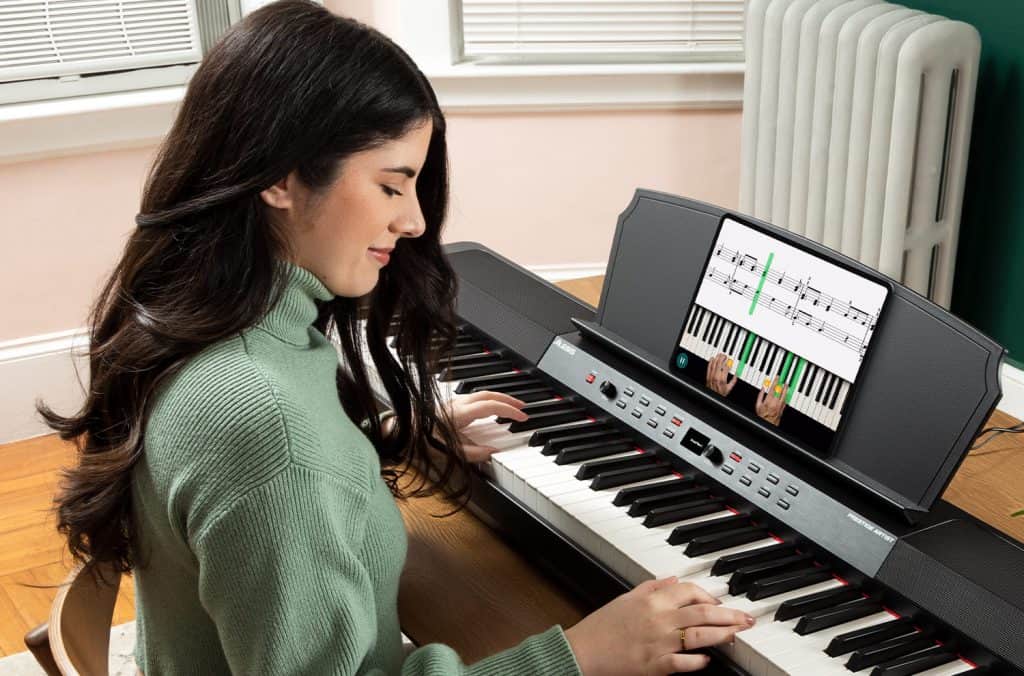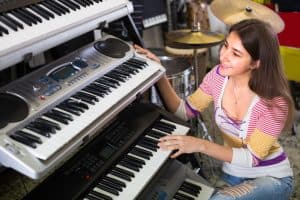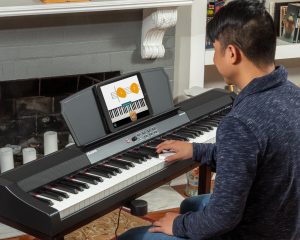You have just bought your first digital piano. Congratulations! Having an instrument of your own that you can practice on is a great decision. Relying on borrowed instruments or your computer keyboard to learn the piano is not an ideal situation.
There are many different varieties of digital pianos and they all arrive in various states of readiness. Just like with any creative tool, it is useful to understand the different components that make up your digital piano, how you can set it up for optimal performance, and the various quirks and subtleties of your particular instrument.
This week, we will dive into some basics of your new digital piano and explore the different ways you can set it up f or your ideal setting.

The benefits of a digital piano
A digital piano has numerous benefits, making them ideal for beginning pianists. Some of the benefits include:
- Digital pianos are often much less expensive than traditional acoustic pianos.
- Digital pianos are lighter and easier to move than traditional acoustic pianos.
- Digital pianos generally do not require the same amount of maintenance as acoustic pianos.
- Digital pianos can offer a wider range of sounds than acoustic pianos, which can be fun and exciting to explore for creative purposes.
- Digital pianos are adjustable regarding the volume of sound
- Digital pianos come with a headphone output
Things to consider before setup
There are some elements you should consider before setting up your new digital piano. Taking the time to consider these situations will help ensure an ideal setting for your new piano.
Your home space
Where in your home will your new digital piano go? Do you have a place picked out? One advantage of digital pianos is the space requirement is considerably less than an acoustic piano. You can easily move a digital piano to a new place in your home if you desire.
How your piano will arrive
Will your piano arrive directly to your house? Will you pick up your piano from a store or dealer? In either case, your piano will have been shipped at some point, meaning it will likely have spent a considerable amount of time packed in a box and shipped on an airplane or in a truck. Obviously, this is not always an ideal way to transport musical instruments and there can be complications.
Piano bench and other accessories
Does your digital piano come with a piano bench? What about a music stand? Does it have built-in speakers? Or will you use headphones or an amplifier to hear the piano? These are important considerations to make and will affect how you set up your new piano.
If your piano does not come with a bench, it would be wise to invest in a solid piano bench. Having proper posture from the beginning will help ensure you develop good piano technique and do not feel uncomfortable during or after practicing.
Likewise, having a music stand will be helpful to read music and write notes. A successful trick is to always keep paper and pencil handy on your stand so that you can jot down notes and inspiration the moment it strikes during your online piano lessons!
Things to watch out for in digital pianos
Since digital pianos have been shipped at some point, problems can arise. Here are some key things to watch out for with your new digital piano:
- Your keyboard should play at the same volume throughout the entire keyboard. If there are fluctuations in volume while you press the keys with the same touch, there is a problem.
- There should be no excess noise or scratch sounds when you press the keys.
- Your digital piano should play in tune throughout the entire length of the keyboard. Test this out with a few piano chords to check.
What parts make up a digital piano?
A digital piano is made of several different parts. The primary component is the keyboard. The keyboard is the most intuitive part of the digital piano. It is where you connect with the instrument and produce sound. Depending on your instrument, the keys are built from some combination of wood and plastic. Likewise, depending on your instrument, your keyboard will either have semi-weighted or weighted keys.
The circuit board is what lies inside of your digital piano and translates the touch of the keys into sound. It is probably the most fragile, and simultaneously the most valuable, aspect of your digital piano. Be sure to maintain a consistent climate and be gentle if you carry your digital piano around.
Your digital piano may come with some piano pedals as well. Some digital pianos have three pedals like an acoustic piano. Other digital pianos do not come with any pedals and you will need to purchase a stand-alone sustain pedal if you want to have that sound.
How to set the height of your piano bench
Setting the proper height of your piano bench is crucial to developing good piano posture. You want to sit with your feet firmly on the ground, your elbows at about 90 degrees and your shoulders relaxed and comfortable. You do not want any tension in your hands while you practice piano scales!
Your hands should be parallel to the keys and slightly curved. You do not want to be sitting too far below your piano or too far above. Your hands should not be at too deep of an angle below the keys as this can result in unnecessary tension in your wrists.
FAQ
Can a digital piano be out of tune?
Digital pianos are generally not out of tune. Many digital pianos come with a tuning adjustment knob on them. You can alter the tuning of your digital piano if you like.
How long do digital pianos last?
Digital pianos are designed to last for a long time. If you take care of your instrument and treat it well, your digital piano will last a long time.
Should I unplug the digital piano?
You do not need to unplug the digital piano every time you are finished practicing. However, you should remember to turn off your piano when you are done with your session. You do not want it to overheat!
Tying it all together
A digital piano is a great way to break into the world of piano playing. Since they are more affordable and more convenient in your home than a traditional acoustic piano, they are a great option for many people. However, there are some things you need to watch out for with your digital piano. Keep these things in mind as you start to explore with your piano. And remember, that Skoove is here to help you at every step of your piano journey!
Author of this blog post:

Eddie Bond is a multi-instrumentalist performer, composer, and music instructor currently based in Seattle, Washington USA. He has performed extensively in the US, Canada, Argentina, and China, released over 40 albums, and has over a decade experience working with music students of all ages and ability levels.















